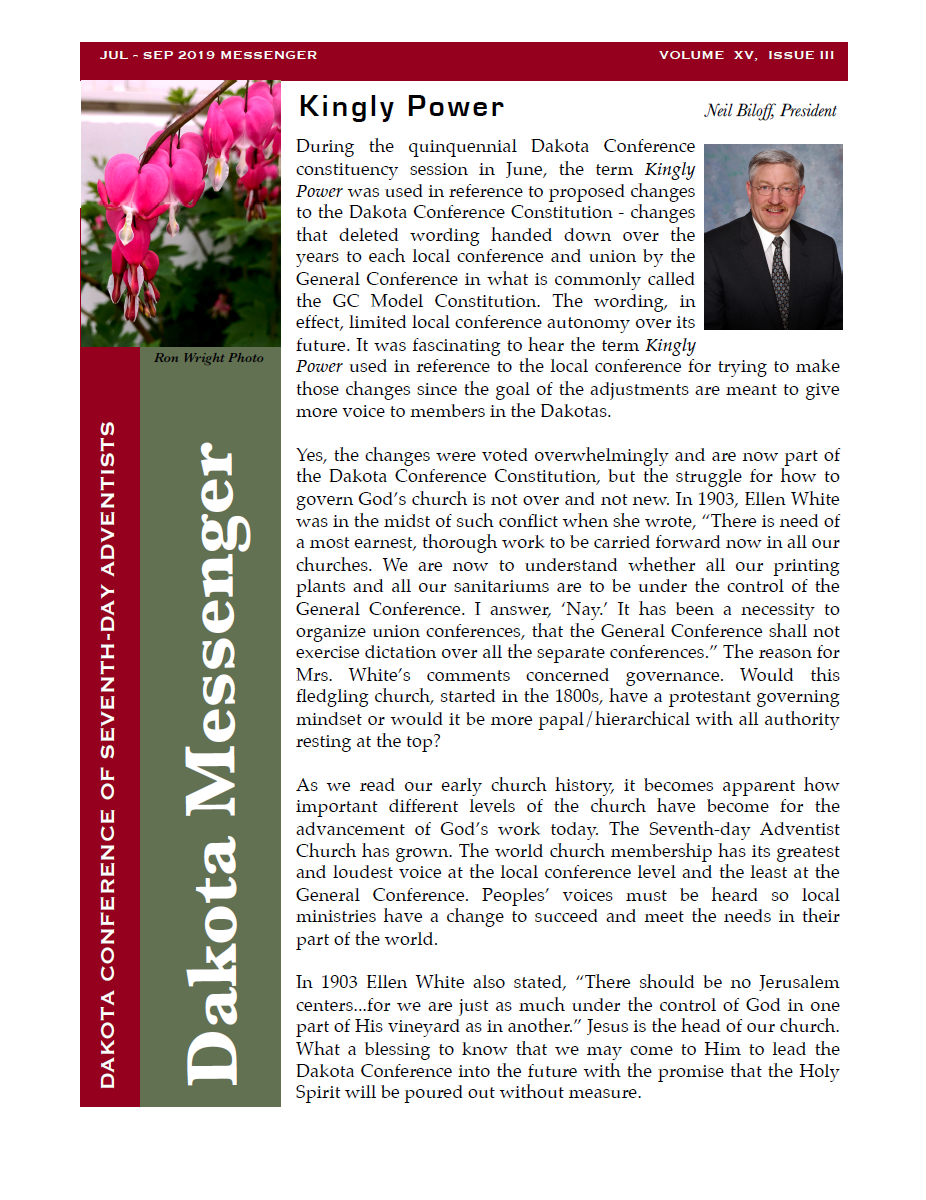On June 16 of this year the Dakota Conference held their Constituency meeting at the Dakota Adventist Academy. There were two significant outcomes of that meeting.
The Dakota Conference recommended changes to their Constitution Bylaws (Article II, Purpose) which removed a clause that they would pursue the mission of the Church “within the doctrinal guidelines adopted and approved by the General Conference in its quinquennial session”(s). They also struck a reference to the working policies and procedures of the North American Division (which arise from the General Conference Model Constitution).
In lieu of the General Conference doctrinal guidelines, the Dakota Conference retained language in Article II that aligns them with the Mid-America Union and the North American Division. They also added language about the 28 Fundamental Beliefs.
There was a motion to table the Bylaws changes on lines 64—68 to make sure that these changes would not put the Dakota Conference out of compliance with the General Conference (or World Church). That motion failed.
These bylaw changes passed by a vote of 72% in favor to 28% opposed.
Article in the Dakota Messenger
Commentary
Dakota President, Neil Biloff, recently wrote an article in the Dakota Messenger titled “Kingly Power.” In this article he defends the changes to the Dakota Conference Constitution. This defense is obviously in response to flack that the Dakota Conference has received in the last 60-days.
Biloff acknowledges in the article that the Dakota Conference has been accused of exercising “kingly power” in their efforts to change their Conference Constitution bylaws. He suggests—in his article—that it is the GC who is in danger of wielding “kingly power.” He quotes a 1903 EGW statement to imply that the Dakota Conference is on the right side of a struggle for the governance of God’s Church.
Some out-of-compliance defiant church entities are now claiming loyalty to the 28 Fundamental Beliefs as an excuse for jettisoning their loyalty to the world Church. Look for it.
Without mentioning the word congregationalism, Biloff’s article attempts to make a compelling case for it. “Peoples’ voices must be heard so local ministries have a change [should be chance] to succeed and meet the needs in their part of the world.” Under the guise of empowering the Conference, church organization is discounted—wrapped in a kind of parochial congregationalist mentality that essentially says “Forget the foreign fields, we have our task here.”
Biloff’s article reveals that substantial conflicting currents now run through our church. At Fulcrum7 we try to observe and report on the transcendence and confluence of these currents. The former zeal for sharing Bible truths, of working together in close community, of a world-encompassing vision of a great task to be done in preparation for Christ’s Return, is diminishing in North America.
Notice how the Dakota Conference preserved their ties to the Mid-America Union and the North American Division in Article II, while severing their connection to doctrinal guidelines of the General Conference (world church)? That is intentional.
The Mid-America Union Executive Committee voted on March 8, 2012 to support the ordination of women in their Union territory. This happened under the oversight of then President Tom Lemon (the same individual who was sent around by the GC Unity and Mission Oversight Committee in 2017 to see if there was rebellion among pro-women ordination factions in the Seventh-day Adventist Church. He said he couldn’t find any rebellion..
In November of 2018, the Dakota Conference President, Neil Biloff asked that an item be placed on MAUC’s regularly scheduled 2021 Constituency Session agenda to provide ordination opportunities for all pastors in Mid-America, without regard for gender. It should be obvious by now that Mr. Biloff has an agenda. The motion carried.
You may be thinking, “Isn’t it disingenuous for a Conference to minimize their loyalty to the World Church, maximize it towards a Union, and demand that their constituents remain loyal to them?” Yes, of course it is.
As a (mostly) liberal North American Division has secured the ideological support of it’s Unions, so the Unions are seeking the unified support of their Conferences. Look for Conferences to also step up demands for the support of local churches, although they tend to be more cautious there. They don’t want to get the Seventh-day Adventist church members riled up. They are easier to control when they aren’t riled up.
What is behind these demands for organizational diversity? The root cause is a desire for doctrinal diversity.
****
“For this reason I left you in Crete, that you should set in order the things that are lacking, and appoint elders in every city as I commanded you—if a man is blameless, the husband of one wife, having faithful children not accused of dissipation or insubordination. For a bishop must be blameless, as a steward of God, not self-willed, not quick-tempered, not given to wine, not violent, not greedy for money, but hospitable, a lover of what is good, sober-minded, just, holy, self-controlled, holding fast the faithful word as he has been taught, that he may be able, by sound doctrine, both to exhort and convict those who contradict” (Titus 1:9-9).



